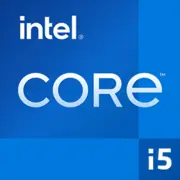Intel Core i5-12600K

Intel Core i5-12600K: Recensione completa del processore del 2025
Rilevanza nel 2025 e caratteristiche principali
Architettura e specifiche principali
Il processore Intel Core i5-12600K, lanciato alla fine del 2021, continua a essere una scelta popolare per le configurazioni di fascia media e alta grazie all’architettura ibrida Alder Lake.
Processo tecnologico e core
- Processo tecnologico: Intel 7 (10 nm Enhanced SuperFin).
- Core e thread: 10 core (6 Performance-core + 4 Efficient-core) e 16 thread.
- Frequenze: P-core fino a 4.9 GHz in modalità turbo, E-core fino a 3.6 GHz.
- Cache: 20 MB L3.
Caratteristiche principali:
- Thread Director — ottimizzazione della distribuzione dei compiti tra i core.
- Supporto per PCIe 5.0 e DDR5 (compatibilità con DDR4 mantenuta).
- Intel UHD Graphics 770 — grafica integrata per compiti di base.
Prestazioni:
- Geekbench 6: 2442 (Single-Core), 11784 (Multi-Core).
- Nei giochi (ad esempio, Cyberpunk 2077) raggiunge 90-120 FPS abbinato a RTX 4070 in risoluzione 1440p.
Schede madri compatibili
Il processore utilizza il socket LGA 1700, che consente di scegliere schede basate sui chipset Z690, B660, H610 (per la 12a generazione) o Z790 (versione aggiornata con supporto migliorato per DDR5).
Raccomandazioni:
- Per l'overclocking: ASUS ROG Strix Z790-E Gaming (~$350) — VRM stabile, PCIe 5.0.
- Opzione budget: MSI PRO B660M-A DDR4 (~$130) — ottimale per DDR4.
- Caratteristiche di scelta:
- I chipset Z690/Z790 supportano l’overclocking di CPU e RAM.
- B660 — overclock della memoria, ma non del processore.
Supporto della memoria: DDR4 vs DDR5
Il processore mantiene la sua rilevanza grazie alla flessibilità:
- DDR4-3200: Kit economici (32 GB ~$80), incremento minimo nei giochi rispetto a DDR5.
- DDR5-6000: Raccomandato per compiti professionali (32 GB ~$150).
Esempio: In Adobe Premiere il rendering con DDR5 si conclude con un 15-20% di velocità superiore. Per i giochi, la differenza tra DDR4 e DDR5 nel 2025 è di circa 5-8% (ad esempio, in Hogwarts Legacy).
Alimentatori: calcolo della potenza
Con TDP di 125 W e consumo massimo fino a 150 W (in test di stress):
- Minimo: 650 W (ad esempio, Corsair RM650x, ~$110).
- Con riserva: 750-850 W (se si utilizza una GPU di livello RTX 4080/7900 XT).
Consigli:
- Scegliere alimentatori con certificazione 80+ Gold o superiore.
- Considerare un cavo da 8 pin separato per la CPU.
Pro e contro
Punti di forza:
1. Architettura ibrida — efficiente nel multitasking.
2. Supporto DDR4/DDR5 — risparmio o upgrade.
3. Ottime prestazioni in giochi e applicazioni lavorative.
Punti deboli:
1. Alto calore dissipato — necessità di un buon dissipatore (ad esempio, Noctua NH-D15).
2. Prezzo: Nel 2025, il processore costa ~$220, mentre i concorrenti in questo segmento offrono tecnologie più recenti.
Scenari d'uso
1. Giochi: Ideale per 1440p/4K in abbinamento a una scheda video di livello RTX 4070 Ti.
2. Compiti lavorativi: Montaggio video (DaVinci Resolve), rendering 3D (Blender).
3. Multimedia: Streaming (OBS + NVENC) senza lag.
Esempio reale: Una configurazione con i5-12600K e RTX 4060 Ti riesce a gestire lo streaming su Twitch a 1080p@60fps con un carico della CPU di ~70%.
Confronto con i concorrenti
- AMD Ryzen 5 7600X (~$250):
- Pro: maggiore IPC, supporto DDR5-6000.
- Contro: più costoso, richiede scheda AM5.
- Intel Core i5-13600K (~$300):
- +15% Multi-Core, ma prezzo maggiore.
Conclusione: l’i5-12600K è vantaggioso per chi ha un budget limitato, soprattutto se si ha accesso a DDR4.
Consigli pratici per la costruzione
1. Raffreddamento: Minimo dissipatore ad torre (DeepCool AK620, ~$60).
2. Memoria: Per i giochi — 32 GB DDR4-3600, per il lavoro — DDR5-6000.
3. Scheda madre: Se non si prevede di overcloccare — B660, per tuning — Z790.
4. Case: Assicurati che abbia una buona ventilazione (esempio — Lian Li Lancool III).
Conclusione finale: A chi si adatta l’i5-12600K?
Questo processore è da scegliere se:
- È necessario un equilibrio tra prezzo e prestazioni nel 2025.
- Si ha accesso a DDR4, ma si desidera mantenere la possibilità di un upgrade a DDR5.
- L'obiettivo è una configurazione per giochi o carichi di lavoro misti (giochi + rendering).
Alternative: Se il budget lo consente, considera l’i5-13600K o il Ryzen 7 7700X. Tuttavia, per la maggior parte degli utenti, l’i5-12600K rimane un “compromesso d'oro” anche dopo quattro anni dalla sua uscita.
I prezzi sono aggiornati ad aprile 2025. Indicati per dispositivi nuovi.
Di base
Specifiche della CPU
Specifiche della memoria
Specifiche della GPU
Varie
Classifiche
Rispetto ad altre CPU
Condividi sui social media
Oppure linkaci
<a href="https://cputronic.com/it/cpu/intel-core-i5-12600k" target="_blank">Intel Core i5-12600K</a>